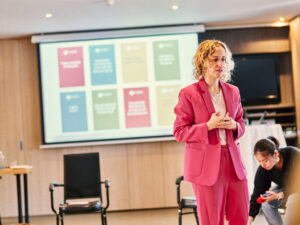Whether you call it the New, Hybrid or Future Way of Working, it’s clear that there’s no ‘going back to normal’ from before COVID-19 hit. But what will the workforce look like post-pandemic? We believe that new trends & challenges such as accelerated digitization and more remote work require a new set of B’s – Business, Belonging, and Balance.
The post-pandemic workforce
Recently, McKinsey surveyed 800 executives on what they envision for the postpandemic workforce and identified 4 trends:
Accelerated digitisation
Restrictions on travel and physical interactions forced organizations to adopt new technologies much faster than ever before. 85% of respondents said their organizations accelerated the implementation of technologies such as videoconferencing and file-sharing, enabling employee interaction and collaboration.
More remote work
Before the pandemic, many organizations were reluctant to allow employees to work from home, mainly because they were scared of productivity losses or a negative impact on the company culture. Now, companies see benefits in increased remote work such as lower real estate costs and new ways to compete for talent.
Increased roles in health & hygiene
The COVID-19 outbreak and subsequent measures and regulations stressed the importance of clean and safe workplaces. Companies will invest in health and hygiene by using robots to clean floors or even kill bacteria and by increasing the number of workers specialized in ventilation and elevator operations.
Higher demand for contractors
Organizations will rely more heavily on contractors and temporary workers for onsite roles, due to cost reductions installed to survive the crisis and uncertainty of how the pandemic will play out and when the global economy will be restored leads to
New trends, new challenges
These trends come with challenges based around the well-known 3 B’s of Bricks, Bytes, and Behavior. However, dealing with these trends is not merely a practical/technological challenge. It is in an essence an adaptive challenge. One that requires an additional set of B’s:
Business
- Focus on the organizational level
- How will we work together, manage responsibilities, and keep the business going?
Belonging
- Focus on the team level
- How do we maintain a good culture and support team cohesion and connection?
Balance
- Focus on the individual level
- How do we take care of ourselves and build up resilience?
These three B’s are equally important. Putting too much focus on business without looking at belonging and balance on will lead to a disconnected, unengaged workforce. At the same time, we need to ensure clients are being serviced. Fixating only on balance and belonging in these challenging times and neglecting business will impact productivity.
It’s only when both business, belonging, and balance are catered for that you will get your people and business to thrive. Together.
So, you better get prepared, establish new practices, get your people up to speed with the right mindset and necessary skills, and make work great again.





